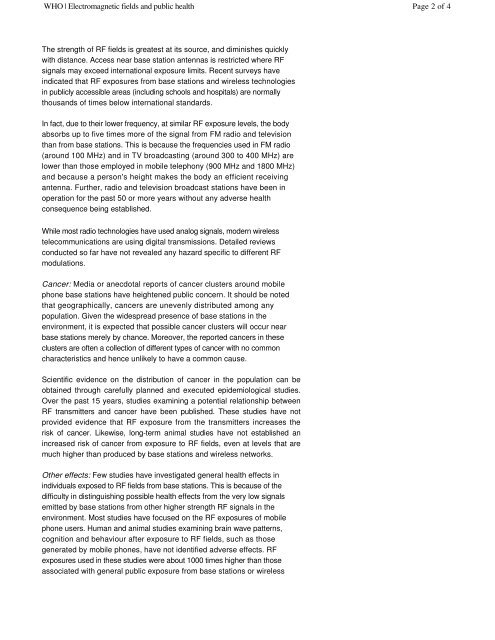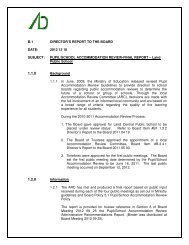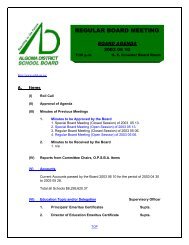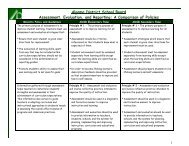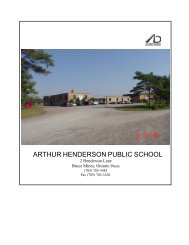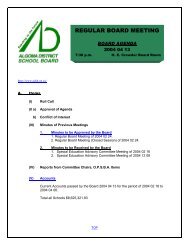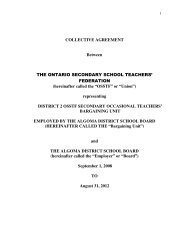Wireless Technology Use in Schools - Algoma District School Board
Wireless Technology Use in Schools - Algoma District School Board
Wireless Technology Use in Schools - Algoma District School Board
Create successful ePaper yourself
Turn your PDF publications into a flip-book with our unique Google optimized e-Paper software.
WHO | Electromagnetic fields and public health Page 2 of 4The strength of RF fields is greatest at its source, and dim<strong>in</strong>ishes quicklywith distance. Access near base station antennas is restricted where RFsignals may exceed <strong>in</strong>ternational exposure limits. Recent surveys have<strong>in</strong>dicated that RF exposures from base stations and wireless technologies<strong>in</strong> publicly accessible areas (<strong>in</strong>clud<strong>in</strong>g schools and hospitals) are normallythousands of times below <strong>in</strong>ternational standards.In fact, due to their lower frequency, at similar RF exposure levels, the bodyabsorbs up to five times more of the signal from FM radio and televisionthan from base stations. This is because the frequencies used <strong>in</strong> FM radio(around 100 MHz) and <strong>in</strong> TV broadcast<strong>in</strong>g (around 300 to 400 MHz) arelower than those employed <strong>in</strong> mobile telephony (900 MHz and 1800 MHz)and because a person's height makes the body an efficient receiv<strong>in</strong>gantenna. Further, radio and television broadcast stations have been <strong>in</strong>operation for the past 50 or more years without any adverse healthconsequence be<strong>in</strong>g established.While most radio technologies have used analog signals, modern wirelesstelecommunications are us<strong>in</strong>g digital transmissions. Detailed reviewsconducted so far have not revealed any hazard specific to different RFmodulations.Cancer: Media or anecdotal reports of cancer clusters around mobilephone base stations have heightened public concern. It should be notedthat geographically, cancers are unevenly distributed among anypopulation. Given the widespread presence of base stations <strong>in</strong> theenvironment, it is expected that possible cancer clusters will occur nearbase stations merely by chance. Moreover, the reported cancers <strong>in</strong> theseclusters are often a collection of different types of cancer with no commoncharacteristics and hence unlikely to have a common cause.Scientific evidence on the distribution of cancer <strong>in</strong> the population can beobta<strong>in</strong>ed through carefully planned and executed epidemiological studies.Over the past 15 years, studies exam<strong>in</strong><strong>in</strong>g a potential relationship betweenRF transmitters and cancer have been published. These studies have notprovided evidence that RF exposure from the transmitters <strong>in</strong>creases therisk of cancer. Likewise, long-term animal studies have not established an<strong>in</strong>creased risk of cancer from exposure to RF fields, even at levels that aremuch higher than produced by base stations and wireless networks.Other effects: Few studies have <strong>in</strong>vestigated general health effects <strong>in</strong><strong>in</strong>dividuals exposed to RF fields from base stations. This is because of thedifficulty <strong>in</strong> dist<strong>in</strong>guish<strong>in</strong>g possible health effects from the very low signalsemitted by base stations from other higher strength RF signals <strong>in</strong> theenvironment. Most studies have focused on the RF exposures of mobilephone users. Human and animal studies exam<strong>in</strong><strong>in</strong>g bra<strong>in</strong> wave patterns,cognition and behaviour after exposure to RF fields, such as thosegenerated by mobile phones, have not identified adverse effects. RFexposures used <strong>in</strong> these studies were about 1000 times higher than thoseassociated with general public exposure from base stations or wireless


